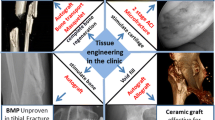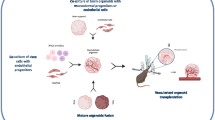Abstract
In this study the detailed morphology and the function of cartilage canals in the chicken femur are investigated. Several embryonic stages (e 13.5, 16, 19, and 20) are examined by means of light microscopy, electron microscopy (TEM), and immunohistochemistry (VEGF, type I and II collagen). Our results show that cartilage canals originate from the perichondrium and form a complex pattern. Two types of canals are distinguishable: shell canals and communicating canals. Shell canals are in the reserve zone and are arranged in successive layers. Communicating canals spring from the shell canals and pass down into the proliferative zone and into the hypertrophic zone. These canals are conical shaped and are orientated nearly in parallel to the long axis of the femur. Cartilage canals comprise venules, arterioles, capillaries (mature and immature), and undifferentiated mesenchymal cells. No canal wall in the sense of an epithelium is elaborated. VEGF is detected in both types of canals and macrophages are found at the end of the cartilage canals. We conclude that the growth factor stimulates angiogenesis and that the latter cells erode the matrix ahead of the canals and thus enable the advancement of the vessels. The results clearly show that the canal matrix differs from the remaining cartilage matrix. The canal matrix contains type I collagen, few type II collagen fibrils and proteoglycans are lacking. In contrast, in the cartilage matrix type II collagen and proteoglycans are abundant but no type I collagen is found. Communicating canals are surrounded by a distinct layer of type I collagen indicating that osteoid is formed around these canals. Hypertrophic chondrocytes label for type I collagen and it seemed possible that chondrocytes adjacent to the communicating canals differentiate into bone-forming cells. Our results provide evidence that cartilage canals are involved in nourishment of the cartilage as well as in the ossification process.




Similar content being viewed by others
References
Agrawal P, Atre PR, Kulkarni DS (1984) The role of cartilage canals in the ossification of the talus. Acta Anat (Basel) 119:238–240
Aharinejad S, Marks SC, Jr., Bock P, Mason-Savas A, MacKay CA, Larson EK, Jackson ME, Luftensteiner M, Wiesbauer E (1995) CSF-1 treatment promotes angiogenesis in the metaphysis of osteopetrotic rats. Bone 16:315–324
Arnold M (1968) IV Histochemische Reaktionen. In: Arnold M (ed) Histochemie. Springer, Berlin Heidelberg New York, pp 34–100
Blumer MJF, Gahleitner P, Narzt T, Handl C, Ruthensteiner B (2002) Ribbons of semi-thin sections: an advanced method with a new type of diamond knife. J Neurosci Methods 120:11–16
Carlevaro MF, Cermelli S, Cancedda R, Descalzi Cancedda F (2000) Vascular endothelial growth factor (VEGF) in cartilage neovascularization and chondrocyte differentiation: auto-paracrine role during endochondral bone formation. J Cell Sci 113:59–69
Chappard D, Alexandre C, Riffat G (1986) Uncalcified cartilage resorption in human fetal cartilage canals. Tissue Cell 18:701–707
Claassen H, Kirsch T, Simons G (1996) Cartilage canals in human thyroid cartilage characterized by immunolocalization of collagen types I, II, pro-III, IV and X. Anat Embryo 194:147–153
Cole AA, Cole MB (1989) Are perivascular cells in cartilage canals chondrocytes? J Anat 165:1–8
Cole AA, Wezeman FH (1985) Perivascular cells in cartilage canals of the developing mouse epiphysis. Am J Anat 174:119–129
Doménech-Ratto G, Fernández-Villacañas Marín M, Ballester-Moreno A, Doménech-Asensi P (1999) Development and segments of cartilage canals in the chick embryo. A light microscope study. Eur J Anat 3:121–126
Doménech-Ratto G, Moreno-Cascales M, Ballester-Moreno A (1992) Origine et distribution des canaux cartilagineux dans l’embryon de poulet. Acta Anat (Basel) 144:320–324
Fritsch H, Brenner E, Debbage P (2001) Ossification in the human calcaneus: a model for spatial bone development and ossification. J Anat 199:609–616
Fritsch H, Eggers R (1999) Ossification of the calcaneus in the normal fetal foot and in clubfoot. J Pediatr Orthop 19:22–26
Galotto M, Campanile G, Robino G, Cancedda FD, Bianco P, Cancedda R (1994) Hypertrophic chondrocytes undergo further differentiation to osteoblast-like cells and participate in the initial bone formation in developing chick embryo. J Bone Miner Res 9:1239–1249
Ganey TM, Ogden JA, Sasse J, Neame PJ, Hilebilnk DR (1995) Basement membrane composition of cartilage canals during development and ossification of the epiphysis. Anat Rec 241:425–437
Gruber HE, Lachman RS, Rimoin DL (1990) Quantitative histology of cartilage vascular canals in the human rib. Findings in normal neonates and children and in achondrogenesis II-hypochondrogenesis. J Anat 173:69–75
Haines RW (1933) Cartilage canals. J Anat 68:45–64
Hall BK (1983) Collagens of cartilage. In: Hall BK (ed) Cartilage, vol 1. Structure, function, and biochemistry. Academic Press, New York, pp 181–214
Hascall GK (1980) Cartilage proteoglycans: comparison of sectioned and spread whole molecules. J Ultrastruct Res 70:369–375
Hintzsche E (1928) Untersuchungen an Stützgeweben. I. Über die Bedeutung der Gefäßkanäle im Knorpel nach Befunden am distalen Ende des menschlichen Schenkelbeines. Zeitschr Mikrosk Anat Forschung 12:61–126
Hunt CD, Ollerich DA, Nielsen FH (1979) Morphology of the perforating cartilage canals in the proximal tibial growth plate of the chick. Anat Rec 194:143–157
Hunter W (1743) On the structure and diseases of articular cartilage. Phil Trans B 42:514–521
Kugler JH, Tomlinson A, Wagstaff A, Ward SM (1979) The role of cartilage canals in the formation of secondary centres of ossification. J Anat 129:493–506
Langer K (1876) Über das Gefäßsystem der Röhrenknochen, mit Beiträgen zur Kenntnis des Baus und der Entwicklung des Knochengewebes. Denkschr K Akad Wissensch Wien Math-naturw Klasse 36:1–40
Levene C (1964) The patterns of cartilage canals. J Anat 98:515–538
Lutfi AM (1970A) Mode of growth, fate and functions of cartilage canals. J Anat 106:135–145
Lutfi AM (1970B) Study of cell multiplication in the cartilaginous upper end of the tibia of the domestic fowl by tritiated thymidine autoradiography. Acta Anat (Basel) 76:454–463
Lutfi AM (1971) The fate of chondrocytes during cartilage erosion in the growing tibia in the domestic fowl (Gallus domesticus). Acta Anat (Basel) 79:27–35
Petersen W, Tsokos M, Pufe T (2002) Expression of VEGF121 and VEGF165 in hypertrophic chondrocytes of the human growth plate and epiphyseal cartilage. J Anat 201:153–157
Roach HI (1997) New aspects of endochondral ossification in the chick: chondrocyte apoptosis, bone formation by former chondrocytes, and acid phosphatase activity in the endochondral bone matrix. J Bone Miner Res 12(5):795–805
Roach HI, Erenpreisa J, Aigner T (1995) Osteogenic differentiation of hypertrophic chondrocytes involves asymmetric cell divisions and apoptosis. J Cell Biol 131(2):483–494
Roach HI, Baker JE, Clarke NM (1998) Initiation of the bony epiphysis in long bones: chronology of interactions between the vascular system and the chondrocytes. J Bone Miner Res 13(6):950–961
Schenk RK, Wiener J, Spiro D (1968) Fine structural aspects of vascular invasion of the tibial epiphyseal plate of growing rats. Acta Anat (Basel) 69:1–17
Shapiro IM, Boyde A (1987) Mineralization of normal and rachitic chick growth cartilage: vascular canals, cartilage calcification and osteogenesis. Scanning Microsc 1:599–606
Stockwell RA (1971) The ultrastructure of cartilage canals and the surrounding cartilage in the sheep fetus. J Anat 109:397–410
Wilsman NJ, Van Sickle DC (1972) Cartilage canals, their morphology and distribution. Anat Rec 173:79–93
Acknowledgements
We thank “Geflügelzucht Moser” and Prof. Dr. H. Dietrich for kindly providing the material. We are indebted to Prof. Dr. P. Debbage for his valuable advice on the use of the VEGF antibody. We thank Dr. M.T. Perez and Prof. Dr. M. Hess for discussion and critical reading of the manuscript. We specially thank E. Richter for technical help in immunohistochemistry.
Author information
Authors and Affiliations
Corresponding author
Rights and permissions
About this article
Cite this article
Blumer, M.J.F., Fritsch, H., Pfaller, K. et al. Cartilage canals in the chicken embryo: ultrastructure and function. Anat Embryol 207, 453–462 (2004). https://doi.org/10.1007/s00429-003-0363-0
Accepted:
Published:
Issue Date:
DOI: https://doi.org/10.1007/s00429-003-0363-0




